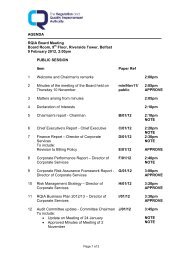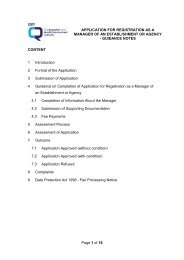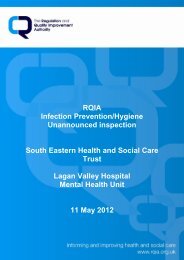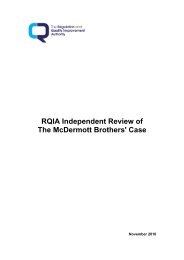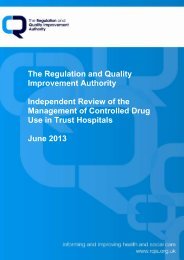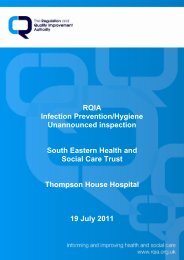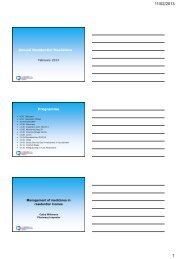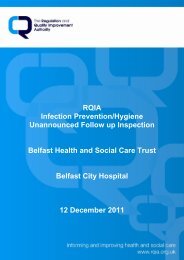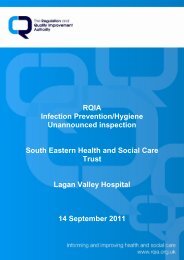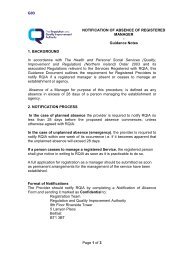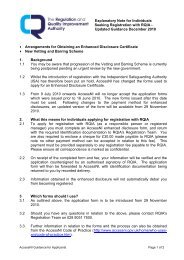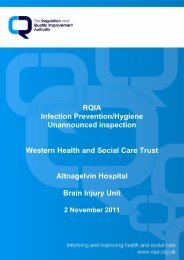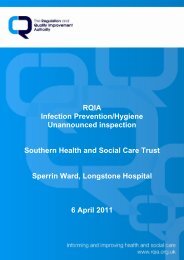Royal Victoria Hospital, Belfast - 17 July 2012 - Regulation and ...
Royal Victoria Hospital, Belfast - 17 July 2012 - Regulation and ...
Royal Victoria Hospital, Belfast - 17 July 2012 - Regulation and ...
Create successful ePaper yourself
Turn your PDF publications into a flip-book with our unique Google optimized e-Paper software.
RQIA<br />
Infection Prevention/Hygiene<br />
Unannounced Inspection<br />
<strong>Belfast</strong> Health <strong>and</strong> Social Care Trust<br />
<strong>Royal</strong> <strong>Victoria</strong> <strong>Hospital</strong><br />
<strong>17</strong> <strong>July</strong> <strong>2012</strong>
Contents<br />
1.0 Inspection Summary 1<br />
2.0 Background Information to the Inspection Process 6<br />
3.0 Inspections 6<br />
4.0 Unannounced Inspections Process 7<br />
4.1 Onsite Inspection 7<br />
4.2 Feedback <strong>and</strong> Report of the findings 7<br />
5.0 Audit Tool 8<br />
6.0 Environment 10<br />
6.1 Cleaning 10<br />
6.2 Clutter 12<br />
6.3 Maintenance <strong>and</strong> Repair 13<br />
6.4 Fixture <strong>and</strong> Fittings 14<br />
6.5 Information 14<br />
6.6 Additional Issues 15<br />
7.0 Patient Linen <strong>17</strong><br />
7.1 Management of Linen <strong>17</strong><br />
8.0 Waste <strong>and</strong> Sharps 19<br />
8.1 Waste 19<br />
8.2 Sharps 19<br />
8.3 Additional Issue Ward 7B 20<br />
9.0 Patient Equipment 22<br />
10.0 Hygiene Factors 24<br />
11.0 Hygiene Practice 25<br />
12.0 Key Personnel <strong>and</strong> Information 29<br />
13.0 Summary of Recommendations 31<br />
14.0 Unannounced Inspection Flowchart 33<br />
15.0 RQIA Hygiene Team Escalation Policy Flowchart 34<br />
16.0 Action Plan 35
1.0 Inspection Summary<br />
An unannounced inspection was undertaken to the <strong>Royal</strong> <strong>Victoria</strong><br />
<strong>Hospital</strong>, on the <strong>17</strong> <strong>July</strong> <strong>2012</strong>. The hospital was assessed against the<br />
Regional Healthcare Hygiene <strong>and</strong> Cleanliness St<strong>and</strong>ards <strong>and</strong> the<br />
following areas were inspected:<br />
• Ward 4C - Orthopaedic<br />
• Ward 5A - Vascular<br />
• Ward 6A - Gastro-intestinal Surgery<br />
• Ward 7B - Medical Respiratory<br />
Inspection Outcomes<br />
Overall the inspection teams found evidence that the <strong>Royal</strong> <strong>Victoria</strong><br />
<strong>Hospital</strong> was working to comply with the Regional Healthcare Hygiene<br />
<strong>and</strong> Cleanliness st<strong>and</strong>ards. Improvements in the overall levels of<br />
compliance have been noted since the previous inspection, three of the<br />
wards achieved an overall partially compliant score <strong>and</strong> Ward 6A<br />
achieved an overall compliant score.<br />
Inspectors found that further improvement was required in the following<br />
areas. The environment in all wards required attention to detail where<br />
cleaning; clutter, <strong>and</strong> at times poor maintenance <strong>and</strong> repair, notably in<br />
Ward 5A, have impacted negatively on the scoring.<br />
Although all wards scored overall compliance for the st<strong>and</strong>ard<br />
regarding hygiene factors, the section on materials <strong>and</strong> equipment for<br />
cleaning, indicates that more work is required to improve practice. In<br />
the hygiene practices st<strong>and</strong>ard, Ward 4C scored a minimal compliance<br />
in the section h<strong>and</strong> hygiene procedures <strong>and</strong> none of the wards were<br />
compliant for the section concerning effective cleaning of the ward. In<br />
all wards, all staff groups must implement hygiene <strong>and</strong> infection<br />
prevention <strong>and</strong> control practices consistently to minimise the potential<br />
risk of transmission of infection to patients, visitors <strong>and</strong> staff. As a<br />
result of the findings for Wards 4C <strong>and</strong> 5A a follow up inspection will be<br />
carried out within three months.<br />
The inspectors noted that good practice by staff resulted in compliance<br />
in the following sections of the audit tool; the management of waste<br />
<strong>and</strong> used linen <strong>and</strong> within the Hygiene Factors <strong>and</strong> Hygiene Practices<br />
st<strong>and</strong>ards.<br />
The inspection resulted in 22 recommendations for the BHSCT <strong>and</strong> the<br />
<strong>Royal</strong> <strong>Victoria</strong> <strong>Hospital</strong>, a full list of recommendations is listed in<br />
Section 13.<br />
A detailed list of preliminary findings is forwarded to <strong>Belfast</strong> Health <strong>and</strong><br />
Social Care Trust within 14 days of the inspection to enable early<br />
action on identified areas which have achieved non complaint scores.<br />
1
The draft report which includes the high level recommendations in a<br />
Quality Improvement Plan is forwarded within 28 days of the inspection<br />
for agreement <strong>and</strong> factual accuracy. The draft report is agreed <strong>and</strong> a<br />
completed action plan is returned to RQIA within 14 days from the date<br />
of issue. The detailed list of preliminary findings is available from RQIA<br />
on request.<br />
The final report <strong>and</strong> Quality Improvement Plan will be available on the<br />
RQIA website. Reports <strong>and</strong> action plans will be subject to performance<br />
management by the Health <strong>and</strong> Social Care Board <strong>and</strong> the Public<br />
Health Agency.<br />
Notable Practice<br />
The inspection identified the following areas of notable practice:<br />
• Care bundles are performed for insertion <strong>and</strong> maintenance of<br />
peripheral IV lines, maintenance of central lines <strong>and</strong> urinary<br />
catheterization<br />
• Audits are carried out on; h<strong>and</strong> hygiene, peripheral vascular<br />
catheters, central venous catheters, urinary catheter care<br />
• Ward 5A has implemented a care bundle for the acutely ill<br />
patient<br />
• Vapourised hydrogen peroxide cleans are carried following<br />
discharge of patients with VRE (Vancomycin Resistant<br />
Enterococcus) infection<br />
• Ward 6A has initiated a “Body Chart” for use with each<br />
patient. This is a good visual trigger for staff to quickly<br />
identify catheters, cannulae, wounds, pressure areas<br />
• In Ward 6A <strong>and</strong> 7B, the use of the electronic h<strong>and</strong>over tool<br />
has shortened h<strong>and</strong>over time to approximately 10 minutes<br />
<strong>and</strong> can highlight IPC issues for staff<br />
The RQIA inspection team would like to thank the BHSCT <strong>and</strong> in<br />
particular all staff at the <strong>Royal</strong> <strong>Victoria</strong> <strong>Hospital</strong> for their assistance<br />
during the inspection.<br />
The following tables give an overview of compliance scores noted in<br />
areas inspected by RQIA:<br />
Table 1 summarises the overall compliance levels achieved.<br />
Tables 2-7 summarise the individual tables for sections two to seven of<br />
the audit tool as this assists the organisation to target areas that<br />
require more specific attention.<br />
2
Table 1<br />
Ward 4C 5A 6A 7B<br />
Environment 80 70 81 80<br />
Patient Linen 87 88 89 83<br />
Waste 88 86 89 86<br />
Sharps 79 76 94 79<br />
Equipment 81 76 88 86<br />
Hygiene Factors 92 88 91 87<br />
Hygiene Practices 81 89 90 90<br />
Total 84 82 89 84<br />
Table 2<br />
Environment 4C 5A 6A 7B<br />
Reception N/A N/A 70 N/A<br />
Corridors, stairs lift 88 83 81 95<br />
Public toilets 86 N/A 84 N/A<br />
Ward/department –<br />
general (communal)<br />
90 72 79 80<br />
Patient bed area 83 72 84 77<br />
Bathroom/washroom 87 65 79 94<br />
Toilet N/A N/A 87 79<br />
Clinical room/treatment<br />
room<br />
66 50 96 74<br />
Clean utility room 85 59 76 80<br />
Dirty utility room 86 71 75 73<br />
Domestic store 73 64 81 79<br />
Kitchen N/A 57 78 67<br />
Equipment store 67 80 81 81<br />
Isolation 76 86 79 73<br />
General information 60 85 81 85<br />
Total 80 70 81 80<br />
Table 3<br />
Linen 4C 5A 6A 7B<br />
Storage of clean linen 79 81 83 65<br />
Storage of used linen 94 94 94 100<br />
Laundry facilities N/A N/A N/A N/A<br />
Total 87 88 89 83<br />
Compliant:<br />
85% or above<br />
Partial Compliance: 76% to 84%<br />
Minimal Compliance: 75% or below<br />
3
Table 4<br />
Waste <strong>and</strong> sharps 4C 5A 6A 7B<br />
H<strong>and</strong>ling, segregation,<br />
storage, waste<br />
88 86 89 86<br />
Availability, use,<br />
storage of sharps<br />
79 76 94 79<br />
Table 5<br />
Patient Equipment 4C 5A 6A 7B<br />
Patient equipment 81 76 88 86<br />
Table 6<br />
Hygiene Factors 4C 5A 6A 7B<br />
Availability <strong>and</strong><br />
cleanliness of WHB <strong>and</strong> 94 91 91 85<br />
consumables<br />
Availability of alcohol<br />
rub<br />
100 100 97 93<br />
Availability of PPE 94 100 93 93<br />
Materials <strong>and</strong><br />
equipment for cleaning<br />
79 59 83 77<br />
Total 92 88 91 87<br />
Table 7<br />
Hygiene Practices 4C 5A 6A 7B<br />
Effective h<strong>and</strong> hygiene<br />
procedures<br />
71 85 94 80<br />
Safe h<strong>and</strong>ling <strong>and</strong><br />
disposal of sharps<br />
100 100 100 100<br />
Effective use of PPE 86 100 94 100<br />
Correct use of isolation 82 N/A 88 86<br />
Effective cleaning of<br />
ward<br />
76 74 76 80<br />
Staff uniform <strong>and</strong> work<br />
wear<br />
72 86 90 93<br />
Total 81 89 90 90<br />
Compliant:<br />
85% or above<br />
Partial Compliance: 76% to 84%<br />
Minimal Compliance: 75% or below<br />
4
2.0 Background Information to the Inspection Process<br />
RQIA’s infection prevention <strong>and</strong> hygiene team was established to<br />
undertake a rolling programme of unannounced inspections of acute<br />
hospitals. The Department of Health Social Service <strong>and</strong> Public Safety<br />
(DHSSPS) commitment to a programme of hygiene inspections was<br />
reaffirmed through the launch in 2010 of the revised <strong>and</strong> updated<br />
version of 'Changing the Culture' the strategic regional action plan for<br />
the prevention <strong>and</strong> control of healthcare-associated infections (HCAIs)<br />
in Northern Irel<strong>and</strong>.<br />
The aims of the inspection process are:<br />
• to provide public assurance <strong>and</strong> to promote public trust <strong>and</strong><br />
confidence<br />
• to contribute to the prevention <strong>and</strong> control of HCAI<br />
• to contribute to improvement in hygiene, cleanliness <strong>and</strong> infection<br />
prevention <strong>and</strong> control across health <strong>and</strong> social care in Northern<br />
Irel<strong>and</strong><br />
In keeping with the aims of the RQIA, the team will adopt an open <strong>and</strong><br />
transparent method for inspection, using st<strong>and</strong>ardised processes <strong>and</strong><br />
documentation.<br />
5
3.0 Inspections<br />
The DHSSPS has devised draft Regional Healthcare Hygiene <strong>and</strong><br />
Cleanliness st<strong>and</strong>ards. RQIA has revised its inspection processes to<br />
support the publication of the st<strong>and</strong>ards which were compiled by a<br />
regional steering group in consultation with service providers.<br />
RQIA's infection prevention/hygiene team have planned a three year<br />
programme which includes announced <strong>and</strong> unannounced inspections<br />
in acute <strong>and</strong> non-acute hospitals in Northern Irel<strong>and</strong>. This will assess<br />
compliance with the DHSSPS Regional Healthcare Hygiene <strong>and</strong><br />
Cleanliness st<strong>and</strong>ards.<br />
The inspections will be undertaken in accordance with the four core<br />
activities outlined in the RQIA Corporate Strategy, these include:<br />
• Improving care: we encourage <strong>and</strong> promote improvements in the<br />
safety <strong>and</strong> quality of services through the regulation <strong>and</strong> review of<br />
health <strong>and</strong> social care<br />
• Informing the population: we publicly report on the safety,<br />
quality <strong>and</strong> availability of health <strong>and</strong> social care<br />
• Safeguarding rights: we act to protect the rights of all people<br />
using health <strong>and</strong> social care services<br />
• Influencing policy: we influence policy <strong>and</strong> st<strong>and</strong>ards in health<br />
<strong>and</strong> social care<br />
6
4.0 Unannounced Inspection Process<br />
Trusts receive no advanced notice of the onsite inspection. An email<br />
<strong>and</strong> telephone call will be made by the Chief Executive of RQIA or<br />
nominated person 30 minutes prior to the team arriving on site. The<br />
inspection flow chart is attached in Section 14.<br />
4.1 Onsite Inspection<br />
The inspection team was made up of four inspectors from RQIA’s<br />
infection prevention/hygiene team along with four peer reviewers. One<br />
inspector led the team <strong>and</strong> was responsible for guiding the team <strong>and</strong><br />
ensuring they were in agreement about the findings reached.<br />
Membership of the inspection team is outlined in Section 12.<br />
The inspection of ward environments is carried out using the draft<br />
Regional Healthcare Hygiene <strong>and</strong> Cleanliness audit tool. The<br />
inspection process involves observation, discussion with staff, <strong>and</strong><br />
review of some ward documentation.<br />
4.2 Feedback <strong>and</strong> Report of the Findings<br />
The process concludes with a feedback of key findings to trust<br />
representatives including examples of notable practice identified during<br />
the inspection. The details of trust representatives attending the<br />
feedback session is outlined in Section 12.<br />
The findings, report <strong>and</strong> follow up action will be in accordance with the<br />
Infection Prevention/Hygiene Inspection Process (methodology, follow<br />
up <strong>and</strong> reporting).<br />
The infection prevention/hygiene team escalation process will be<br />
followed if inspectors/reviewers identify any serious concerns during<br />
the inspection (Section 15).<br />
A number of documents have been developed to support <strong>and</strong> explain<br />
the inspection process. This information is currently available on<br />
request <strong>and</strong> will be available in due course on the RQIA website.<br />
7
5.0 Audit Tool<br />
The audit tool used for the inspection is based on the draft Regional<br />
Healthcare Hygiene <strong>and</strong> Cleanliness st<strong>and</strong>ards. The st<strong>and</strong>ards<br />
incorporate the critical areas which were identified through a review of<br />
existing st<strong>and</strong>ards, guidance <strong>and</strong> audit tools (Appendix 2 of Regional<br />
Healthcare Hygiene <strong>and</strong> Cleanliness st<strong>and</strong>ards). The audit tool follows<br />
the format of the draft Regional Healthcare Hygiene <strong>and</strong> Cleanliness<br />
St<strong>and</strong>ards <strong>and</strong> comprises of the following sections.<br />
1. Organisational Systems <strong>and</strong> Governance: policies <strong>and</strong><br />
procedures in relation to key hygiene <strong>and</strong> cleanliness issues;<br />
communication of policies <strong>and</strong> procedures; roles <strong>and</strong><br />
responsibilities for hygiene <strong>and</strong> cleanliness issues; internal<br />
monitoring arrangements; arrangements to address issues<br />
identified during internal monitoring; communication of internal<br />
monitoring results to staff<br />
This st<strong>and</strong>ard is not audited when carrying out unannounced<br />
inspections however the findings of the organisational<br />
system <strong>and</strong> governance at annual announced inspection will<br />
be, where applicable, confirmed at ward level.<br />
2. General Environment: cleanliness <strong>and</strong> state of repair of public<br />
areas; cleanliness <strong>and</strong> state of repair of ward/department<br />
infrastructure; cleanliness <strong>and</strong> state of repair of patient bed area;<br />
cleanliness <strong>and</strong> state of repair of toilets, bathrooms <strong>and</strong><br />
washrooms; cleanliness <strong>and</strong> state of repair of ward/department<br />
facilities; availability <strong>and</strong> cleanliness of isolation facilities;<br />
provision of information for staff, patients <strong>and</strong> visitors<br />
3. Patient Linen: storage of clean linen; h<strong>and</strong>ling <strong>and</strong> storage of<br />
used linen; ward/department laundry facilities<br />
4. Waste <strong>and</strong> Sharps: waste h<strong>and</strong>ling; availability <strong>and</strong> storage of<br />
sharps containers<br />
5. Patient Equipment: cleanliness <strong>and</strong> state of repair of general<br />
patient equipment<br />
6. Hygiene Factors: h<strong>and</strong> wash facilities; alcohol h<strong>and</strong> rub;<br />
availability of personal protective equipment (PPE); availability of<br />
cleaning equipment <strong>and</strong> materials<br />
7. Hygiene Practices: h<strong>and</strong> hygiene procedures; h<strong>and</strong>ling <strong>and</strong><br />
disposal of sharps; use of PPE; use of isolation facilities <strong>and</strong><br />
implementation of infection control procedures; cleaning of<br />
ward/department; staff uniform <strong>and</strong> work wear<br />
8
Level of Compliance<br />
Percentage scores can be allocated a level of compliance using the<br />
compliance categories below. The categories are allocated as follows:<br />
Compliant<br />
85% or above<br />
Partial compliance 76 to 84%<br />
Minimal compliance 75% or below<br />
Each section within the audit tool will receive an individual <strong>and</strong> an<br />
overall score, to identify areas of partial or minimal compliance to<br />
ensure that the appropriate action is taken.<br />
9
6.0 Environment<br />
STANDARD 2.0<br />
GENERAL ENVIRONMENT<br />
Cleanliness <strong>and</strong> state of repair of public areas; cleanliness <strong>and</strong><br />
state of repair of ward/department infrastructure; cleanliness <strong>and</strong><br />
state of repair of patient bed area; cleanliness <strong>and</strong> state of repair<br />
of toilets, bathrooms <strong>and</strong> washrooms; cleanliness <strong>and</strong> state of<br />
repair of ward/department facilities; availability <strong>and</strong> cleanliness<br />
of isolation facilities; provision of information for staff, patients<br />
<strong>and</strong> visitors.<br />
Environment 4C 5A 6A 7B<br />
Reception N/A N/A 70 N/A<br />
Corridors, stairs lift 88 83 81 95<br />
Public toilets 86 N/A 84 N/A<br />
Ward/department –<br />
general (communal)<br />
90 72 79 80<br />
Patient bed area 83 72 84 77<br />
Bathroom/washroom 87 65 79 94<br />
Toilet N/A N/A 87 79<br />
Clinical room/treatment<br />
room<br />
66 50 96 74<br />
Clean utility room 85 59 76 80<br />
Dirty utility room 86 71 75 73<br />
Domestic store 73 64 81 79<br />
Kitchen N/A 57 78 67<br />
Equipment store 67 80 81 81<br />
Isolation 76 86 79 73<br />
General information 60 85 81 85<br />
Total 80 70 81 80<br />
The above table outlines the findings in relation to the general<br />
environment of the facilities inspected where none of the wards<br />
achieved compliance in this st<strong>and</strong>ard. The findings indicate that there<br />
were areas for improvement in all wards, notably Ward 5A, where<br />
clutter, the poor repair <strong>and</strong> cleaning of the fabric of the building, fixtures<br />
<strong>and</strong> fittings have contributed to the minimally compliant areas<br />
highlighted in red. The findings in respect of the general environment<br />
are detailed in the following sections.<br />
6.1 Cleaning<br />
At the time of the inspection there was evidence in some areas to<br />
indicate compliance with regional specifications for cleaning. However,<br />
the inspectors observed that while cleaning mechanisms were in place<br />
to prevent the build up of dust, debris <strong>and</strong> bacteria <strong>and</strong> subsequently<br />
10
educe the potential risk for the transmission of infection, they were not<br />
always implemented or adhered to.<br />
Ward 5A was minimally compliant for the majority of criteria within this<br />
st<strong>and</strong>ard with an overall minimally compliant score. A concentrated<br />
effort is required by staff in all wards to improve cleaning practice.<br />
In the main reception area, walls <strong>and</strong> flooring were stained, the edges<br />
of the stairs <strong>and</strong> ceiling air vents had a build up of dust, external<br />
windows were smeared, public telephones were dirty <strong>and</strong> had paper<br />
labels attached to the wall mounted frame. Dust was also noted on the<br />
plants, the wooden panelling housing the plants <strong>and</strong> on the window sill<br />
<strong>and</strong> in the radiator cover of the public toilet. Similar issues were noted<br />
in the public toilet of Ward 4C where the vinyl flooring was grubby, the<br />
air vent was dusty <strong>and</strong> the door was stained.<br />
In the corridors leading to Wards 4C, 5A <strong>and</strong> 7B green algae was<br />
present on some window panels <strong>and</strong> cobwebs were observed in the<br />
lobby outside Wards 6A <strong>and</strong> 5A. Greater attention to detail when<br />
cleaning window sills, external windows, stained flooring, corners <strong>and</strong><br />
edges of flooring was required in the lobby of Ward 6A. Similarly, in<br />
Ward 5A, the lift doors <strong>and</strong> ceiling tiles were stained, sticky h<strong>and</strong> marks<br />
were noted on windows <strong>and</strong> sticky adhesive residue on the public<br />
telephone.<br />
In all wards inspected greater attention to detail was required when<br />
cleaning, to ensure dust, debris <strong>and</strong> stains are removed from all high<br />
<strong>and</strong> low horizontal surfaces, such as skirting, radiators, walls <strong>and</strong><br />
flooring. The interior <strong>and</strong> exterior of high density shelving, windows,<br />
lights <strong>and</strong> vents, all fixtures <strong>and</strong> fittings, including sanitary, dirty utility<br />
<strong>and</strong> disposal areas required attention. Inspectors observed that<br />
adhesive tape was used to attach labels or posters to surfaces which in<br />
some instances had left a sticky residue, impeding the cleaning<br />
process.<br />
Lime scale was observed on taps. Particular care is required to ensure<br />
that lime scale is removed from taps <strong>and</strong> fittings as recent evidence<br />
has shown that lime scale may harbour biofilms <strong>and</strong> the build-up of<br />
lime scale can interfere with good cleaning <strong>and</strong> disinfection by masking<br />
<strong>and</strong> protecting pathogens.<br />
In Wards 6A <strong>and</strong> 7B shower chairs were stained, in Ward 5A, the<br />
inside <strong>and</strong> outside of the toilet bowl, the underneath of the toilet seat<br />
<strong>and</strong> the toilet brush <strong>and</strong> holder required cleaning.<br />
Wards 4C, 5A <strong>and</strong> 6A require further work to ensure that the inside/<br />
outside of the drugs’ fridges <strong>and</strong> door touch points throughout the<br />
wards are clean. In Wards 4C, 5A <strong>and</strong> 7B temperature recordings<br />
were inconsistent <strong>and</strong> record sheets did not all provide evidence for<br />
11
ecord variations outside recommended temperature ranges or actions<br />
taken.<br />
Cleaning issues such as dust on horizontal surfaces, debris in corners<br />
<strong>and</strong> edges of flooring, grubby pull cords <strong>and</strong> h<strong>and</strong> washing facilities<br />
<strong>and</strong> excess toilet rolls were identified in rooms designated for isolation<br />
purposes. In Ward 4C a room had been treated with Vaporised<br />
Hydrogen Peroxide (VHP) however, the cleaning process had not been<br />
completed to an acceptable st<strong>and</strong>ard. Surfaces were still dusty, the<br />
suction canister, disposable ear phones, soap <strong>and</strong> hibiscrub dispensers<br />
had not been removed prior to the treatment <strong>and</strong> there were footprints<br />
on the patient wash chair. In Ward 7B the rim of the toilet bowl <strong>and</strong> the<br />
shower chair were stained, in Ward 6A the shower drain, shower panel<br />
<strong>and</strong> toilet seat were dirty.<br />
Catering kitchens were inspected on Levels 5, 6 <strong>and</strong> 7. Level 6 was<br />
partially compliant; Levels 5 <strong>and</strong> 7 were minimally compliant. Flooring,<br />
skirting, horizontal surfaces, taps <strong>and</strong> sinks, some fixtures <strong>and</strong> fittings<br />
required more in depth cleaning. In Level 5, the hot water geyser, the<br />
exterior of cleaned water jugs <strong>and</strong> the inside of the dishwasher were<br />
dirty. Opened food was not stored in sealed, airtight containers, work<br />
surfaces were grubby. In Level 7, surfaces were untidy <strong>and</strong> cluttered,<br />
many kitchen appliances were stained, the Gastnorm tray was on the<br />
floor, fly screens <strong>and</strong> the dishwasher were dirty <strong>and</strong> catering staff were<br />
observed not wearing head gear when plating up chicken.<br />
6.2 Clutter<br />
The provision of clutter free wards <strong>and</strong> effective utilisation of space <strong>and</strong><br />
good stock management assists with effective cleaning in the wards<br />
(Picture 1). Inspectors however noted in Ward 4C a cage containing<br />
stores, a mattress <strong>and</strong> a bed were in the corridor outside the ward <strong>and</strong><br />
the equipment store, also used as a staff locker room <strong>and</strong> domestic<br />
store was disorganised <strong>and</strong> very cluttered (Picture 2). The on going<br />
refurbishment of Ward 6A contributed to the storage of domestic<br />
equipment cluttering the dirty utility room <strong>and</strong> unfixed shelving littering<br />
the floor of the equipment store <strong>and</strong> reducing storage capabilities within<br />
the room.<br />
12
Picture 1: Tidy mail box storage<br />
Picture 2: Cluttered locker room<br />
in Ward 4C<br />
The clean utility rooms <strong>and</strong> domestic stores of Wards 5A <strong>and</strong> 7B did<br />
not have sufficient space to allow for effective storage of equipment<br />
<strong>and</strong> patient equipment was stored in both treatment rooms. In Ward<br />
7B, the 6 bedded bays appeared cramped with little space between<br />
beds <strong>and</strong> the displaying of cards on wall trunking created a cluttered<br />
environment. There was inadequate shelving in the dirty utility room<br />
<strong>and</strong> patient equipment was stored in the en-suite of a room used for<br />
isolation purposes.<br />
The lobby of Ward 5A was cluttered with a bicycle, chair, transport<br />
cage <strong>and</strong> pharmacy boxes, the latter two blocking access to the public<br />
telephone. Shelving units in the equipment store were cluttered <strong>and</strong><br />
untidy, communal toiletries were present in shower rooms. Excess<br />
toilet rolls were noted in toilet areas of Wards 5A, 6A <strong>and</strong> 7B.<br />
6.3 Maintenance <strong>and</strong> Repair<br />
Inspectors observed that in the main reception, the entrance doors<br />
were damaged, there was minor wall damage, <strong>and</strong> the wooden<br />
panelling, reception desk <strong>and</strong> internal frame at the glass brick window<br />
were worn, exposing bare wood.<br />
In all wards inspected, inspectors noted wall, door <strong>and</strong> paintwork<br />
damage. It was evident that staff practice in propping doors open with<br />
waste bins or storing equipment against walls has in some part<br />
contributed to the wall <strong>and</strong> door damage observed. In Ward 4C<br />
inspectors observed holes in the shower room wall from removed<br />
fixtures <strong>and</strong> skirting poorly joined in the treatment room. Flooring was<br />
damaged in Wards, 4C, 5A <strong>and</strong> 6A, water leaks were noted in the<br />
kitchens of Levels 5 <strong>and</strong> 7 <strong>and</strong> damaged formica or veneer was<br />
observed on work surfaces <strong>and</strong> at the nurses’ station in Wards 5A <strong>and</strong><br />
6A.<br />
Wall repairs of a poor st<strong>and</strong>ard were noted in Ward 7B. Wall trunking<br />
was damaged, electrical flex was hanging from a ceiling light in a toilet<br />
13
<strong>and</strong> some lights did not work. An issue also observed in Ward 5A<br />
treatment room.<br />
Damaged fly screens <strong>and</strong> radiator covers, displaced or damaged<br />
ceiling tiles, split covers on pull cords <strong>and</strong> rusted shelving in the<br />
chemical cupboard of the domestic store contributed to the minimally<br />
compliant score achieved in Ward 5A for this st<strong>and</strong>ard. The drugs’<br />
fridge was old, worn <strong>and</strong> damaged, an issue also identified in Ward 6A.<br />
In Ward 6A, wiring was exposed on a h<strong>and</strong> held call bell, wall trunking<br />
in the bays <strong>and</strong> the sealant at some h<strong>and</strong> washing sinks were<br />
damaged. Some caps used to cover mirror screws were missing<br />
resulting in rusted screw heads.<br />
6.4 Fixtures <strong>and</strong> Fittings<br />
The fixtures, fittings <strong>and</strong> equipment in all wards were generally fit for<br />
purpose however common issues were identified for action. In Wards<br />
4C, 5A <strong>and</strong> 6A, shower rail fittings were available but there was no<br />
curtain to protect patient’s privacy <strong>and</strong> dignity. The lack of bedpan drip<br />
trays <strong>and</strong> chipped bedrails were noted in Wards 5A, 6A <strong>and</strong> 7B,<br />
bedpan holders were overstocked in Ward 7B.<br />
Vertical blinds <strong>and</strong> wooden chairs were damaged in Wards 6A <strong>and</strong> 7B<br />
<strong>and</strong> there was no sign on the treatment door alerting the storage of<br />
oxygen cylinders. Pillows in Ward 7B did not have plastic protective<br />
covering, inspectors observed stained pillows.<br />
In Ward 6A the leaflet rack in the waiting area was badly damaged <strong>and</strong><br />
the fabric covers on the seating benches were badly stained. At the<br />
feedback trust representatives confirmed these would be replaced.<br />
Also observed were damaged toilet seats <strong>and</strong> worn plugholes, the blue<br />
storage containers in the treatment room were worn <strong>and</strong> damaged.<br />
A mattress spot checked in Ward 4C was damaged, the undercarriage<br />
of a bed was broken <strong>and</strong> privacy curtains were not dated. Privacy<br />
curtains in Ward 5A required changing.<br />
6.5 Information<br />
With the exception of Ward 6A, the trust’s new nursing cleaning<br />
schedules outlining responsibility, equipment <strong>and</strong> frequency of cleaning<br />
were not in place for staff to reference <strong>and</strong> document. Due to on-going<br />
refurbishment of the domestic store in Ward 6A, domestic cleaning<br />
schedules had been removed.<br />
H<strong>and</strong> washing posters in Ward 4C demonstrated a 6 step procedure<br />
instead of the recommended 7 step, information leaflets on MRSA,<br />
Clostridium difficile, general infections or h<strong>and</strong> hygiene were not<br />
available, MRSA leaflets were also not available in Ward 7B.<br />
14
In Wards 4C <strong>and</strong> 5A National Patient Safety Agency (NPSA) guidelines<br />
were not clearly displayed for nursing staff to reference <strong>and</strong> in Ward 6A<br />
there was no poster available on the segregation of linen. In all wards<br />
inspectors observed posters <strong>and</strong> labels which were not laminated <strong>and</strong><br />
posters attached to surfaces with adhesive tape.<br />
6.6 Additional Issues<br />
• User friendly information on h<strong>and</strong> hygiene <strong>and</strong> environmental<br />
cleanliness audits <strong>and</strong> evidence on care bundle performance<br />
(Picture 3) were not displayed in all wards, for example Wards 6A<br />
<strong>and</strong> 7B. Staff in Ward 6A confirmed that the notice board for<br />
displaying the information had been removed for the ongoing<br />
refurbishment.<br />
Picture 3: Notice board displaying audits,<br />
information <strong>and</strong> m<strong>and</strong>atory training dates<br />
• In Ward 6A the original linen store had been spit into a smaller<br />
linen store <strong>and</strong> a domestic sluice room. The sluice room was still<br />
under construction therefore staff were using the domestic store<br />
in Ward 6B to store equipment, material <strong>and</strong> supplies <strong>and</strong> the<br />
nursing sluice to empty buckets.<br />
Recommendations<br />
1. The trust should work to improve, monitor <strong>and</strong> ensure that<br />
environmental cleaning is carried out effectively, that patient<br />
equipment is fit for purpose <strong>and</strong> that the environment is in a<br />
good state of repair.<br />
2. The senior management within trust should ensure that all<br />
staff are aware of their roles <strong>and</strong> responsibilities in<br />
environmental cleaning.<br />
3. The trust should work on the repair <strong>and</strong> maintenance of ward<br />
<strong>and</strong> public environments <strong>and</strong> to replace damaged fixtures<br />
<strong>and</strong> fittings.<br />
15
4. The trust <strong>and</strong> staff should work to improve storage <strong>and</strong><br />
maintain clutter free ward environments.<br />
5. The trust should ensure all relevant information is available<br />
for patients, visitors <strong>and</strong> staff to reference.<br />
6. The trust should continue to roll out the newly developed<br />
nursing cleaning schedules.<br />
7. The trust should ensure that all staff are aware of the<br />
importance of monitoring fridge temperatures.<br />
16
7.0 Patient Linen<br />
STANDARD 3.0<br />
PATIENT LINEN<br />
Storage of clean linen; h<strong>and</strong>ling <strong>and</strong> storage of used linen; ward/<br />
department laundry facilities.<br />
Linen 4C 5A 6A 7B<br />
Storage of clean linen 79 81 83 65<br />
Storage of used linen 94 94 94 100<br />
Laundry facilities N/A N/A N/A N/A<br />
Total 87 88 89 83<br />
7.1 Management of Linen<br />
The poor repair of the linen store affected the levels of compliance in<br />
all wards. Ward 6A was the only linen store which appeared tidy <strong>and</strong><br />
organised, non-linen items contributed to the cluttered environment in<br />
Wards 5A <strong>and</strong> 7B. Shelving was damaged in Ward 5A <strong>and</strong> 7B, wall<br />
damage was noted in all stores except in Ward 7B, although inspectors<br />
noted a wall mounted wooden plinth which could not be effectively<br />
cleaned <strong>and</strong> a missing light cover.<br />
The wooden door frame of Ward 4C was damaged preventing full<br />
closure of the door; the door h<strong>and</strong>le in Ward 7B was broken. In Wards<br />
6A <strong>and</strong> 7B debris was noted on the corners <strong>and</strong> edges of the flooring,<br />
sticky labels were posted untidily on the door.<br />
Washed in stains were noted on bed sheets of two beds in Ward 6A;<br />
staff confirmed that this was an ongoing issue. In Ward 5A the ward<br />
sister advised that on occasions cleaned ‘wet’ sheets were returned to<br />
the ward from the laundry services. At the feedback trust<br />
representatives advised that the laundry company responsible for<br />
laundering linen would be contacted <strong>and</strong> that staff on the wards were to<br />
record <strong>and</strong> inform of any further incidents.<br />
The storage <strong>and</strong> segregation of used linen was generally good, no<br />
issues were identified in Ward 7B where good practices were<br />
observed. In Ward 4C, had the frames of the linen skips been in good<br />
repair full compliance would also have been achieved for this section of<br />
the audit.<br />
Staff practice affected scores in Wards 5A <strong>and</strong> 6A. In Ward 5A<br />
although not observed, nursing staff advised inspectors that they did<br />
not wear personal protective equipment when washing <strong>and</strong> changing a<br />
bed. In Ward 6A inspectors noted used linen which had not been<br />
placed into an alginate bag in a red linen laundry bag designated for<br />
contaminated linen. Staff questioned confirmed the linen was not<br />
<strong>17</strong>
contaminated <strong>and</strong> had been incorrectly disposed of into the wrong linen<br />
skip.<br />
Recommendations<br />
8. The trust should ensure the correct storage of clean linen in<br />
a designated area which is clean <strong>and</strong> fit for purpose.<br />
9. The trust should monitor the implementation of its policies<br />
<strong>and</strong> procedures in respect of the h<strong>and</strong>ling <strong>and</strong> storage of<br />
linen to ensure that safe <strong>and</strong> appropriate practice is in place.<br />
18
8.0 Waste <strong>and</strong> Sharps<br />
STANDARD 4.0<br />
WASTE AND SHARPS<br />
Waste: Effectiveness of arrangements for h<strong>and</strong>ling, segregation,<br />
storage <strong>and</strong> disposal of waste on ward/department<br />
Sharps: Availability, use <strong>and</strong> storage of sharps containers on<br />
ward/department<br />
Waste <strong>and</strong> sharps 4C 5A 6A 7B<br />
H<strong>and</strong>ling, segregation,<br />
storage, waste<br />
88 86 89 86<br />
Availability, use,<br />
storage of sharps<br />
79 76 94 79<br />
8.1 Waste<br />
The inspection evidenced that all wards were compliant for the<br />
h<strong>and</strong>ling, segregation <strong>and</strong> storage of waste st<strong>and</strong>ard. Some issues<br />
however were identified that require attention.<br />
With the exception of Ward 4C damage was noted to waste bins <strong>and</strong> at<br />
least one waste bin in all wards inspected required cleaning.<br />
To encourage good h<strong>and</strong> hygiene practices in all wards inspected, it is<br />
essential that household waste bins are available at all h<strong>and</strong> washing<br />
sinks <strong>and</strong> the placement does not affect patient privacy <strong>and</strong> dignity.<br />
In Bay B Ward 4C the waste bins were located under privacy curtains.<br />
In all wards waste was not disposed of into the correct waste stream<br />
<strong>and</strong> in line with trust policy. The magpie box in Ward 7B designated for<br />
aerosols, broken crockery <strong>and</strong> glass contained a dirty dust pan.<br />
There was pharmacy waste in the magpie boxes of Wards 4C, 5A <strong>and</strong><br />
6A, in Ward 5A pharmacy waste had also been disposed into a yellow<br />
lidded burn bin <strong>and</strong> in Ward 6A into a large sharps box. Ward 4C did<br />
not have a black lidded burn bin.<br />
Incorrect disposal of household waste into the clinical waste stream<br />
was noted in Wards 5A <strong>and</strong> 6A. A sharps box in Ward 5A also<br />
contained household waste, in Ward 4C a sharps box contained used<br />
dressings. Inspectors observed in Ward 7B a clinical waste bag<br />
incorrectly placed in a black lidded household waste bin.<br />
8.2 Sharps<br />
The inspection evidenced that only Ward 6A achieved compliance on<br />
the safe h<strong>and</strong>ling, segregation, storage <strong>and</strong> disposal of sharps<br />
st<strong>and</strong>ard. The ward shares the emergency trolley with Ward 6B.<br />
19
Inspectors were disappointed to note that in this ward the sharps box<br />
on the emergency trolley was not labeled, signed or secure <strong>and</strong> the<br />
temporary closure was open.<br />
Common themes were observed in the other three wards. Temporary<br />
closure mechanisms were not all in place on the sharps boxes when<br />
not in use, sharps boxes on the emergency or drugs trolleys were not<br />
secure or empty <strong>and</strong> sharps trays were stained in Wards 4C <strong>and</strong> 5A.<br />
Inspectors in Wards 5A <strong>and</strong> 7B<br />
observed items such as IV tubing <strong>and</strong><br />
syringe plungers, protruding from<br />
sharps boxes (Picture 4). In Ward 7B<br />
the sharps box on the resuscitation<br />
trolley was not dated, or signed <strong>and</strong><br />
sharps were not disposed of at the<br />
point of care as there were no<br />
compatible sharps boxes for the IV<br />
trays in use.<br />
Picture 4: Protruding plunger in sharps box<br />
8.3 Additional Issue Ward 7B<br />
On entering the treatment room during the inspection the inspector<br />
observed that IV/IM medication had been drawn up <strong>and</strong> left sitting in<br />
trays, this is unsafe practice <strong>and</strong> was addressed immediately by the<br />
nurse <strong>and</strong> brought to the attention of the ward manager. It is<br />
concerning that this issue was also identified on the re-audit of a<br />
different ward last year; this may be a training issue for the trust.<br />
Recommendations<br />
10. The trust should monitor the implementation of its policies<br />
<strong>and</strong> procedures in respect of the management of waste <strong>and</strong><br />
sharps to ensure that safe <strong>and</strong> appropriate practice is in<br />
place.<br />
11. The trust should ensure that waste bins <strong>and</strong> equipment used<br />
in the management of waste are available, kept clean <strong>and</strong><br />
replaced as appropriate.<br />
12. The trust <strong>and</strong> individual staff have a collective responsibility<br />
to ensure that staff knowledge is kept up to date regarding<br />
the safe <strong>and</strong> the correct h<strong>and</strong>ling <strong>and</strong> disposal of waste <strong>and</strong><br />
sharps is adhered to.<br />
20
13. The trust need to review staff practice in relation to the<br />
administration of medications <strong>and</strong> provide training if required.<br />
21
9.0 Patient Equipment<br />
STANDARD 5.0<br />
PATIENT EQUIPMENT<br />
Cleanliness <strong>and</strong> state of repair of general patient equipment.<br />
Patient Equipment 4C 5A 6A 7B<br />
Patient equipment 81 76 88 86<br />
Wards 6A <strong>and</strong> 7B achieved compliance for this st<strong>and</strong>ard; Wards 4C<br />
<strong>and</strong> 5A were partially compliant, issues were identified in all wards<br />
inspected.<br />
Common themes were noted. Trigger tape to denote equipment had<br />
been cleaned <strong>and</strong> was ready to use was not in use in Wards 5A <strong>and</strong><br />
4C, it was sporadically used in Ward 7B. In Ward 7B disposable<br />
tourniquets were not in use, in Ward 6A used disposable tourniquets<br />
had been left on sharps trays, these were discarded immediately by a<br />
senior staff nurse. With the exception of Ward 7B, staff questioned<br />
were unaware of the symbol for single use equipment.<br />
Greater attention to detail when cleaning patient equipment such as the<br />
underside of commodes, walking aids, IV st<strong>and</strong>s, suction machines,<br />
drugs’ <strong>and</strong> resuscitation trolleys <strong>and</strong> re-usable blood pressure cuffs<br />
was required in Wards 4C <strong>and</strong> 7B. Staff in Ward 4C should ensure<br />
stock is regularly rotated <strong>and</strong> adhesive tape <strong>and</strong> plasters removed from<br />
all equipment; in Ward 7B there was no filter on the portable suction<br />
machine. In both wards patient washbowls were not stored inverted to<br />
aid the drying process.<br />
The low partially compliant score in Ward 5A is indicative of patient<br />
equipment which required cleaning, was in poor repair or stored out of<br />
packaging. Items such as Magills forceps, ambu bags <strong>and</strong> masks out<br />
of packaging did not have traceability labels to denote expiry date <strong>and</strong><br />
lot number; some IV bags were also stored out of original packaging.<br />
Detailed cleaning of stored equipment such as IV st<strong>and</strong>s, IV pumps<br />
<strong>and</strong> observation monitors <strong>and</strong> in use drugs’, notes’ <strong>and</strong> dressing<br />
trolleys was required. Some equipment had minor damage such as<br />
chipped framework, the undercarriage of a commode was rusted, the<br />
plastic protective coating on some urinal holders or catheter st<strong>and</strong>s<br />
was missing in places exposing the metal underneath <strong>and</strong> the casing of<br />
a glucose monitor was held together with adhesive tape (Picture 5).<br />
Inspectors noted two bedpans which had been processed by the<br />
washer disinfector had faecal stains present. Staff should ensure<br />
effective cleaning processes are in place.<br />
22
Picture 5: Glucose monitor casing <strong>and</strong><br />
dirty adhesive tape<br />
Patient equipment in Ward 6A was generally visibly clean <strong>and</strong> in good<br />
condition although some bedpans <strong>and</strong> IV st<strong>and</strong>s were old <strong>and</strong> worn.<br />
Blood stains were noted on the glucose monitoring machine <strong>and</strong> the<br />
interior lid of its container.<br />
Recommendations<br />
14. The trust <strong>and</strong> individual staff have a collective responsibility<br />
to ensure that equipment is clean, stored correctly <strong>and</strong> in a<br />
good state of repair.<br />
15. The trust <strong>and</strong> individual staff have a collective responsibility<br />
to ensure that staff knowledge is kept up to date regarding<br />
equipment cleaning.<br />
23
10.0 Hygiene Factors<br />
STANDARD 6.0<br />
HYGIENE FACTORS<br />
H<strong>and</strong> wash facilities; alcohol h<strong>and</strong> rub; availability of PPE;<br />
availability of cleaning equipment <strong>and</strong> materials<br />
Hygiene Factors 4C 5A 6A 7B<br />
Availability <strong>and</strong><br />
cleanliness of WHB <strong>and</strong> 94 91 91 85<br />
consumables<br />
Availability of alcohol<br />
rub<br />
100 100 97 93<br />
Availability of PPE 94 100 93 93<br />
Materials <strong>and</strong><br />
equipment for cleaning<br />
79 59 83 77<br />
Total 92 88 91 87<br />
All wards were compliant for this st<strong>and</strong>ard; Wards 4C <strong>and</strong> 5A were fully<br />
compliant for the sections concerning availability of alcohol rub.<br />
H<strong>and</strong> washing sinks <strong>and</strong> fixtures <strong>and</strong> fittings in all wards were generally<br />
clean, working <strong>and</strong> in a good state of repair however, greater attention<br />
to detail could further improve scoring. In Wards 4C <strong>and</strong> 6A although<br />
clean, some h<strong>and</strong> washing sinks were old, worn or stained, in Ward 4C<br />
the laminate surround was badly worn. Staff in Ward 6A <strong>and</strong> 7B were<br />
unsure who had responsibility for running the sink in the shared<br />
disposal area in line with the trust Legionella control measures.<br />
In Ward 7B the h<strong>and</strong> washing sinks in the clean <strong>and</strong> dirty utility rooms<br />
were not draining properly, the surface was tarnished <strong>and</strong> drainage<br />
holes were dirty. The h<strong>and</strong> washing sink in the treatment room was not<br />
visibly clean, the seal was stained <strong>and</strong> peeling away from the splash<br />
back. There was no soap dispenser in the dirty utility room <strong>and</strong><br />
Chlorhexidine h<strong>and</strong> wash was supplied at all h<strong>and</strong> washing sinks, a<br />
similar issue in Ward 6A.<br />
It is imperative that in order to promote effective h<strong>and</strong> hygiene for staff<br />
<strong>and</strong> visitors that h<strong>and</strong> hygiene consumables are available for use.<br />
There was one alcohol rub dispenser in Ward 6A which was empty, the<br />
h<strong>and</strong> rub container at the entrance to Ward 7B was missing <strong>and</strong><br />
Hydrex dispenser plungers were dirty.<br />
None of the wards was compliant in the section materials <strong>and</strong><br />
equipment for cleaning, Ward 5A was minimally compliant. With the<br />
exception of Ward 7B, inspectors noted chemicals stored in unlocked<br />
cupboards breaching COSHH regulations, in Ward 6B disinfectant<br />
24
tablets were decanted into an unlabelled foil dish, in Ward 6A out of<br />
date cleaning chemicals were in the unlocked equipment store waiting<br />
collection. Trigger spray bottles of air freshener were hanging in<br />
shower rooms in Wards 5A <strong>and</strong> 6A.<br />
In Wards 4C, 5A <strong>and</strong> 6A, some mop buckets were dirty in the crevices,<br />
not all were stored inverted. Mops buckets in Wards 5A <strong>and</strong> one<br />
bucket in Ward 6A were observed stored in the domestic store filled<br />
with solution. In Ward 5A some contained used mop heads, in both<br />
wards some mop heads were soaking in the solution <strong>and</strong> therefore not<br />
laundered after use.<br />
Picture 6: Cloths <strong>and</strong> mops left soaking<br />
in solution<br />
In Ward 5A, a red h<strong>and</strong> held<br />
bucket filled with solution <strong>and</strong><br />
a cloth had been left in the<br />
domestic store <strong>and</strong> not<br />
discarded after use (Picture<br />
6). Mop h<strong>and</strong>les were stored<br />
propped against the wall as<br />
holders were not available.<br />
Dirty, wooden floor brushes,<br />
which cannot be effectively<br />
cleaned were observed, <strong>and</strong><br />
the brushes were not colour<br />
coded in line with NPSA<br />
guidelines.<br />
Dustpans were dirty in Wards 5A, 6A <strong>and</strong> 7B, brushes in Ward 7B also<br />
required cleaning. Cleaning equipment such as burnishers, high<br />
dusters, vacuums were dirty or had minor damage in Ward 5A, floor<br />
polishing pads were dirty in Ward 4C, <strong>and</strong> the polisher was dusty. Dirty<br />
or damaged equipment was observed in Ward 7B, the flex of the<br />
burnisher <strong>and</strong> the vacuum hose was damaged, the castors <strong>and</strong> base of<br />
the burnisher were dusty.<br />
Recommendations<br />
16. The trust should ensure that h<strong>and</strong> washing sinks <strong>and</strong><br />
consumables are available, clean, working <strong>and</strong> in a good<br />
state of repair.<br />
<strong>17</strong>. The trust should ensure that all cleaning products are stored<br />
in a locked cupboard, in line with COSHH regulations.<br />
18. Further attention to detail is required to ensure that<br />
equipment used for the general cleaning purposes of a ward<br />
are clean, used <strong>and</strong> stored appropriately <strong>and</strong> are fit for<br />
purpose.<br />
25
11.0 Hygiene Practices<br />
STANDARD 7.0<br />
HYGIENE PRACTICES<br />
H<strong>and</strong> hygiene procedures; h<strong>and</strong>ling <strong>and</strong> disposal of sharps; use<br />
of PPE; use of isolation facilities <strong>and</strong> implementation of infection<br />
control procedures; cleaning of ward/department; staff uniform<br />
<strong>and</strong> work wear.<br />
Hygiene Practices 4C 5A 6A 7B<br />
Effective h<strong>and</strong> hygiene<br />
procedures<br />
71 85 94 80<br />
Safe h<strong>and</strong>ling <strong>and</strong><br />
disposal of sharps<br />
100 100 100 100<br />
Effective use of PPE 86 100 94 100<br />
Correct use of isolation 82 N/A 88 86<br />
Effective cleaning of<br />
ward<br />
76 74 76 80<br />
Staff uniform <strong>and</strong> work<br />
wear<br />
72 86 90 93<br />
Total 81 89 90 90<br />
With the exception of Ward 4C overall compliance was achieved in this<br />
st<strong>and</strong>ard. Poor h<strong>and</strong> hygiene practices were observed in Ward 4C.<br />
Many staff did not carry out all seven steps of the h<strong>and</strong> wash<br />
technique, staff did not comply with h<strong>and</strong> hygiene in line with the World<br />
Health Organisation (WHO) five moments of care <strong>and</strong> patients were<br />
not offered h<strong>and</strong> hygiene prior to meals. In Ward 7B the majority of<br />
staff observed evidenced effective h<strong>and</strong> hygiene practice however on<br />
two occasions staff did not undertake the seven step technique<br />
properly <strong>and</strong> all but one member of staff used antibacterial h<strong>and</strong> wash<br />
in preference to soap.<br />
Staff in all wards are commended for achieving full compliance for the<br />
section relating to safe h<strong>and</strong>ling <strong>and</strong> disposal of sharps. Wards 5A <strong>and</strong><br />
7B were fully compliant with effective use of PPE. In Ward 4C<br />
domestic staff confirmed they did not wear aprons for wet work <strong>and</strong> a<br />
member of staff was observed not removing gloves after completing an<br />
activity. In Ward 6A a nursing auxiliary was observed leaving an<br />
isolation room having removed PPE <strong>and</strong> not decontaminating their<br />
h<strong>and</strong>s outside the room.<br />
There were no patients requiring isolation precautions in Ward 5A<br />
therefore this section of the tool kit was not scored. In Wards 4C <strong>and</strong><br />
7B inspectors reviewed the notes of a patient with a known infection;<br />
the care pathway was in place however the infection prevention <strong>and</strong><br />
control assessment had not been completed. Additionally, in Ward 7B<br />
26
dust in the isolation room would suggest that cleaning was not being<br />
carried out effectively on a daily basis, while in Ward 4C patients <strong>and</strong><br />
relatives were not provided with relevant information leaflets. A review<br />
of the notes in Ward 6A identified that both the care pathway <strong>and</strong> the<br />
infection, prevention <strong>and</strong> control assessment had not been completed.<br />
To improve practice <strong>and</strong> knowledge in the effective cleaning at ward<br />
level further effort is required in all wards inspected, <strong>and</strong> notably Ward<br />
5A which was minimally compliant in this section. In Ward 5A<br />
registered nursing staff did not routinely clean patient equipment<br />
between use however nursing auxiliary staff did. Some nursing staff<br />
questioned were unaware of the dilution rates for the disinfectant in use<br />
for routine cleaning, none knew the dilution rate for cleaning blood <strong>and</strong><br />
body spillages <strong>and</strong> the NPSA (National Patient Safety Agency) colour<br />
coded system for cleaning.<br />
In Ward 4C there was little evidence to demonstrate patient equipment<br />
was cleaned between use as detergent wipes were exposed <strong>and</strong> dry in<br />
their canisters. Individual bottles of constituted disinfectant bottles<br />
were not dated, NPSA colour coding guidelines were not available for<br />
nursing staff <strong>and</strong> staff were unaware of the need for a decontamination<br />
certificate for equipment needing repaired, serviced or maintained.<br />
Staff in Wards 6A <strong>and</strong> 7B were unable to outline the correct procedure<br />
for cleaning blood <strong>and</strong> body fluid spillage as they did not know the<br />
correct disinfectant dilution rate. Data sheets for the disinfectant in use<br />
were not available in Ward 6A <strong>and</strong> not all nursing staff were aware of<br />
the NPSA colour coding system.<br />
Inspectors observed that the trust has in general implemented the<br />
concept of ‘bare below the elbow’ for staff delivering care. However, in<br />
Ward 4C two members of staff did not comply with the policy, two<br />
members of medical staff wore wrist watches, two members of staff<br />
wore unsecured clothing. In Ward 5A medical staff were observed with<br />
stethoscopes hanging around their necks, a student nurse in Ward 6A<br />
wore false nails. These were removed before the end of the<br />
inspection.<br />
Designated staff changing facilities were not available for nursing <strong>and</strong><br />
domestic staff to change into <strong>and</strong> out of their uniform at work.<br />
Recommendations<br />
19. The trust <strong>and</strong> individual staff have a collective responsibility<br />
to ensure that h<strong>and</strong> hygiene is carried out in line with WHO<br />
guidance <strong>and</strong> that all PPE is used appropriately.<br />
20. The trust <strong>and</strong> individual staff have a collective responsibility<br />
to ensure that staff knowledge is kept up to date with regard<br />
to isolation, cleaning <strong>and</strong> decontamination of equipment.<br />
27
21. The trust <strong>and</strong> individual staff have a collective responsibility<br />
to ensure that staff knowledge is kept up to date regarding<br />
the use of disinfectants.<br />
22. The trust should ensure that all members of staff are familiar<br />
with <strong>and</strong> adhere to the regional dress code policy.<br />
28
12.0 Key Personnel <strong>and</strong> Information<br />
Members of the RQIA inspection team<br />
Mrs E Colgan<br />
Mrs L Gawley<br />
Mrs S O’Connor<br />
Mrs M Keating<br />
- Senior Officer Infection Prevention/Hygiene Team<br />
- Inspector Infection Prevention/Hygiene Team<br />
- Inspector Infection Prevention/Hygiene Team<br />
- Inspector Infection Prevention/Hygiene Team<br />
Peer Reviewers<br />
Janice Clarke<br />
Colin Clarke<br />
Shirley Baird<br />
Noelle Donnelly<br />
- Senior Manager, Patient Experience, SEHSCT<br />
- Lead Nurse, Infection Prevention & Control,<br />
SHSCT<br />
- Sister, North West Independent Clinic<br />
- Assistant Support Services Manager, WHSCT<br />
Trust representatives attending the feedback session<br />
The key findings of the inspection were outlined to the following trust<br />
representatives:<br />
Ms B Creaney<br />
Mr R Sowney<br />
Ms L Linford<br />
Mr C Thomas<br />
Ms K Ms Clenaghan<br />
Ms E McDonald<br />
Ms L Symington<br />
Ms C Lecky<br />
Ms D Cunningham<br />
Ms J Callaghan<br />
Ms R Gillen<br />
Ms S Douthart<br />
Ms J Ms Keown<br />
Ms K Browne<br />
Ms N Scott<br />
Ms C Kearns<br />
Ms K Thompson<br />
- Executive Director of Nursing<br />
- Co Director A/S<br />
- Senior Manager & ADN A/S<br />
- Service Manager Surgery<br />
- Service Manager Specialist Surgery<br />
- Fracture Services Manager<br />
- Assistant Service Manager Surgery<br />
- Assistant Service Manager Medicine<br />
- Acting Ward Manager Ward 6A<br />
- CCO<br />
- Senior Infection Prevention <strong>and</strong> Control Nurse<br />
- Deputy Ward Manager Ward 4C<br />
- Ward Sister 5A<br />
- Ward Sister 7B<br />
- Senior Manager PCSS<br />
- PCSS Operational Manager<br />
- Infection Prevention <strong>and</strong> Control Nurse<br />
Supporting documentation<br />
A number of documents have been developed to support the inspection<br />
process, these are:<br />
• Infection Prevention/Hygiene Inspection Process (methodology,<br />
follow up <strong>and</strong> reporting)<br />
• Infection Prevention/Hygiene Team Inspection Protocol (this<br />
document contains details on how inspections are carried out <strong>and</strong><br />
the composition of the teams)<br />
29
• Infection Prevention/Hygiene Team Escalation Policy<br />
• RQIA Policy <strong>and</strong> Procedure for Use <strong>and</strong> Storage of Digital Images<br />
This information is currently available on request <strong>and</strong> will be available<br />
in due course on the RQIA website.<br />
30
13.0 Summary of Recommendations<br />
1. The trust should work to improve, monitor <strong>and</strong> ensure that<br />
environmental cleaning is carried out effectively, that patient<br />
equipment is fit for purpose <strong>and</strong> that the environment is in a<br />
good state of repair.<br />
2. The senior management within trust should ensure that all<br />
staff are aware of their roles <strong>and</strong> responsibilities in<br />
environmental cleaning.<br />
3. The trust should work on the repair <strong>and</strong> maintenance of ward<br />
<strong>and</strong> public environments <strong>and</strong> to replace damaged fixtures <strong>and</strong><br />
fittings.<br />
4. The trust <strong>and</strong> staff should work to improve storage <strong>and</strong><br />
maintain clutter free ward environments.<br />
5. The trust should ensure all relevant information is available<br />
for patients, visitors <strong>and</strong> staff to reference.<br />
6. The trust should continue to roll out the newly developed<br />
nursing cleaning schedules.<br />
7. The trust should ensure that all staff are aware of the<br />
importance of monitoring fridge temperatures.<br />
8. The trust should ensure the correct storage of clean linen in a<br />
designated area which is clean <strong>and</strong> fit for purpose.<br />
9. The trust should monitor the implementation of its policies<br />
<strong>and</strong> procedures in respect of the h<strong>and</strong>ling <strong>and</strong> storage of linen<br />
to ensure that safe <strong>and</strong> appropriate practice is in place.<br />
10. The trust should monitor the implementation of its policies<br />
<strong>and</strong> procedures in respect of the management of waste <strong>and</strong><br />
sharps to ensure that safe <strong>and</strong> appropriate practice is in place.<br />
11. The trust should ensure that waste bins <strong>and</strong> equipment used<br />
in the management of waste are available, kept clean <strong>and</strong><br />
replaced as appropriate.<br />
12. The trust <strong>and</strong> individual staff have a collective responsibility<br />
to ensure that staff knowledge is kept up to date regarding the<br />
safe <strong>and</strong> the correct h<strong>and</strong>ling <strong>and</strong> disposal of waste <strong>and</strong><br />
sharps is adhered to.<br />
13. The trust need to review staff practice in relation to the<br />
administration of medications <strong>and</strong> provide training if required.<br />
31
14. The trust <strong>and</strong> individual staff have a collective responsibility<br />
to ensure that equipment is clean, stored correctly <strong>and</strong> in a<br />
good state of repair.<br />
15. The trust <strong>and</strong> individual staff have a collective responsibility<br />
to ensure that staff knowledge is kept up to date regarding<br />
equipment cleaning.<br />
16. The trust should ensure that h<strong>and</strong> washing sinks <strong>and</strong><br />
consumables are available, clean, working <strong>and</strong> in a good state<br />
of repair.<br />
<strong>17</strong>. The trust should ensure that all cleaning products are stored<br />
in a locked cupboard, in line with COSHH regulations.<br />
18. Further attention to detail is required to ensure that equipment<br />
used for the general cleaning purposes of a ward are clean,<br />
used <strong>and</strong> stored appropriately <strong>and</strong> are fit for purpose.<br />
19. The trust <strong>and</strong> individual staff have a collective responsibility<br />
to ensure that h<strong>and</strong> hygiene is carried out in line with WHO<br />
guidance <strong>and</strong> that all PPE is used appropriately.<br />
20. The trust <strong>and</strong> individual staff have a collective responsibility<br />
to ensure that staff knowledge is kept up to date with regard to<br />
isolation, cleaning <strong>and</strong> decontamination of equipment.<br />
21. The trust <strong>and</strong> individual staff have a collective responsibility<br />
to ensure that staff knowledge is kept up to date regarding the<br />
use of disinfectants.<br />
22. The trust should ensure that all members of staff are familiar<br />
with <strong>and</strong> adhere to the regional dress code policy.<br />
32
14.0 Unannounced Inspection Flowchart<br />
Plan Programme<br />
Environmental Scan:<br />
Stakeholders & External<br />
Information<br />
Prior to Inspection Year<br />
Plan<br />
Programme<br />
Prioritise Themes & Areas for Core Inspections<br />
Balance Programme<br />
Consider:<br />
Areas of Non-Compliance<br />
Infection Rates<br />
Trust Information<br />
January/February<br />
Schedule Inspections<br />
Prior to Inspection<br />
Identify & Prepare Inspection Team<br />
Episode of Inspection<br />
Day of Inspection<br />
Day of Inspection<br />
Inform Trust<br />
Carry out Inspection<br />
Is there immediate risk<br />
requiring formal escalation?<br />
NO<br />
YES<br />
Invoke<br />
RQIA<br />
IPHTeam<br />
Escalation<br />
Process<br />
A<br />
Day of Inspection<br />
Feedback Session with Trust<br />
14 days after<br />
Inspection<br />
28 days after<br />
Inspection<br />
Preliminary Findings<br />
disseminated to Trust<br />
Draft Report<br />
disseminated to Trust<br />
NO<br />
Does assessment of<br />
the findings require<br />
escalation?<br />
YES<br />
Invoke<br />
RQIA<br />
IPHTeam<br />
Escalation<br />
Process<br />
A<br />
Reporting & Re-Audit<br />
14 days later<br />
Within 0-3 months<br />
Signed Action Plan<br />
received from Trust<br />
Is a Follow-Up required?<br />
Based on Risk Assessment/key<br />
indicators or Unsatisfactory Quality<br />
Improvement Plan (QIP)?<br />
YES<br />
Invoke<br />
Follow-Up<br />
Protocol<br />
Process enables<br />
only 1 Follow-Up<br />
NO<br />
Open Report published to Website<br />
YES<br />
Is Follow-Up<br />
satisfactory?<br />
NO<br />
DHSSPS/HSC<br />
Board/PHA<br />
33
15.0 Escalation Process<br />
RQIA Hygiene Team: Escalation Process<br />
B<br />
RQIA IPH<br />
Team<br />
Escalation<br />
Process<br />
Concern / Allegation / Disclosure<br />
Inform Team Leader / Head of Programme<br />
MINOR/MODERATE<br />
Has the risk been<br />
assessed as Minor,<br />
Moderate or Major?<br />
MAJOR<br />
Inform key contact <strong>and</strong> keep a record<br />
Inform appropriate RQIA Director <strong>and</strong> Chief Executive<br />
Record in final report<br />
Inform Trust / Establishment / Agency<br />
<strong>and</strong> request action plan<br />
Notify Chairperson <strong>and</strong><br />
Board Members<br />
Inform other establishments as appropriate:<br />
E.g.: DHSSPS, RRT, HSC Board, PHA,<br />
Seek assurance on implementation of actions<br />
Take necessary action:<br />
E.g.: Follow-Up Inspection<br />
34
16.0 Action Plan<br />
Reference<br />
number<br />
Recommendations<br />
Designated<br />
department<br />
Action required<br />
Date for<br />
completion/<br />
timescale<br />
1. The trust should work to improve, monitor <strong>and</strong> ensure<br />
that environmental cleaning is carried out effectively,<br />
that patient equipment is fit for purpose <strong>and</strong> that the<br />
environment is in a good state of repair.<br />
Nursing<br />
PCSS<br />
IPC<br />
Work / negotiations in relation to the<br />
cleaning manual are still ongoing. In<br />
particular, there is discussion with<br />
nursing/control of infection with reference to<br />
bed cleaning. Once agreement is reached<br />
the manual will be finalised.<br />
Ongoing<br />
All of these aspects will be monitored<br />
through the programme of Environmental<br />
Cleanliness Audits based on the<br />
Cleanliness Matters Strategy <strong>and</strong> results<br />
fed back through Balanced Scorecards.<br />
2. The senior management within trust should ensure<br />
that all staff are aware of their roles <strong>and</strong><br />
responsibilities in environmental cleaning.<br />
Nursing<br />
PCSS<br />
IPC<br />
‘Roles <strong>and</strong> responsibilities of Staff in<br />
relation to Environmental Cleanliness <strong>and</strong><br />
Cleanliness of Equipment’ policy under<br />
review.<br />
Ongoing<br />
Work / negotiations in relation to the<br />
cleaning manual are still ongoing. In<br />
particular, there is discussion with<br />
nursing/control of infection with reference to<br />
bed cleaning. Once agreement is reached<br />
the manual will be finalised.<br />
All of these aspects will be monitored<br />
through the programme of Environmental<br />
Cleanliness Audits based on the<br />
Cleanliness Matters Strategy <strong>and</strong> results<br />
fed back through Balanced Scorecards.<br />
35
Reference<br />
number<br />
Recommendations<br />
Designated<br />
department<br />
Action required<br />
Date for<br />
completion/<br />
timescale<br />
3. The trust should work on the repair <strong>and</strong> maintenance<br />
of ward <strong>and</strong> public environments <strong>and</strong> to replace<br />
damaged fixtures <strong>and</strong> fittings.<br />
4. The trust <strong>and</strong> staff should work to improve storage<br />
<strong>and</strong> maintain clutter free ward environments.<br />
Estates<br />
IPC<br />
Other<br />
appropriate<br />
staff<br />
All<br />
Directorates<br />
This is ongoing as part of Estate daily<br />
maintenance <strong>and</strong> refurbishment<br />
programmes.<br />
Planned programme of de-clutter <strong>and</strong> deep<br />
cleaning in place. Ongoing space utilisation<br />
<strong>and</strong> de-cluttering is being driven by Service<br />
Managers.<br />
Ongoing<br />
Ongoing<br />
5. The trust should ensure all relevant information is<br />
available for patients, visitors <strong>and</strong> staff to reference.<br />
6. The trust should continue to roll out the newly<br />
developed nursing cleaning schedules.<br />
IPC<br />
Nursing<br />
Nursing<br />
IPECC<br />
All relevant information is now displayed (or<br />
will be displayed following refurbishment).<br />
The Trust has secured funding from the<br />
PHA to take forward the issue of HCAI<br />
communication.<br />
A sub-group of IPECC (Infection Prevention<br />
& Environment <strong>and</strong> Cleanliness<br />
Committee) has been set up to review <strong>and</strong><br />
st<strong>and</strong>ardise cleaning schedules, <strong>and</strong> will<br />
establish any outst<strong>and</strong>ing issues of audit<br />
st<strong>and</strong>ardisation process.<br />
Complete<br />
Complete<br />
Agree a st<strong>and</strong>ardised audit which will be<br />
used in all areas. This will include<br />
st<strong>and</strong>ardised responsibilities. To be kept<br />
under review.<br />
Commenced<br />
Feb <strong>2012</strong><br />
Systematic roll out of the agreed<br />
st<strong>and</strong>ardised audit using the Maximiser<br />
system.<br />
7. The trust should ensure that all staff are aware of the Nursing The Medicines Code outlines procedures Ongoing<br />
36
Reference<br />
number<br />
Recommendations<br />
Designated<br />
department<br />
Action required<br />
Date for<br />
completion/<br />
timescale<br />
importance of monitoring fridge temperatures.<br />
for use of medicine fridges. A<br />
pharmaceutical refrigerator temperature log<br />
sheet is maintained for each individual<br />
fridge, with records being maintained <strong>and</strong><br />
monitored by Ward Managers.<br />
A dishwasher temperature log sheet is<br />
maintained for each individual dishwasher,<br />
where possible, with records being<br />
maintained <strong>and</strong> monitored by Ward<br />
Managers. Not all dishwasher<br />
temperatures can be recorded.<br />
8. The trust should ensure the correct storage of clean<br />
linen in a designated area which is clean <strong>and</strong> fit for<br />
purpose.<br />
Nursing<br />
Guidance regarding storage of linen is in<br />
the Regional Infection Prevention Manual.<br />
Linen storage <strong>and</strong> segregation guidance<br />
has been circulated to all Directorates.<br />
Complete<br />
This states that all linen must be stored off<br />
the floor in a clean dedicated area that<br />
allows for ease of access <strong>and</strong> rotation of<br />
stock <strong>and</strong> that Linen rooms must have<br />
shelving that are easy to clean, <strong>and</strong><br />
cleaning frequencies must be at least<br />
quarterly.<br />
9. The trust should monitor the implementation of its<br />
policies <strong>and</strong> procedures in respect of the h<strong>and</strong>ling <strong>and</strong><br />
storage of linen to ensure that safe <strong>and</strong> appropriate<br />
practice is in place.<br />
Nursing<br />
Guidance regarding storage of linen is in<br />
the Regional Infection Prevention Manual.<br />
Linen storage <strong>and</strong> segregation guidance<br />
has been circulated to all Directorates.<br />
Complete<br />
10. The trust should monitor the implementation of its PCSS The Trust has piloted <strong>and</strong> rolled out across Complete<br />
37
Reference<br />
number<br />
Recommendations<br />
Designated<br />
department<br />
Action required<br />
Date for<br />
completion/<br />
timescale<br />
policies <strong>and</strong> procedures in respect of the<br />
management of waste <strong>and</strong> sharps to ensure that safe<br />
<strong>and</strong> appropriate practice is in place.<br />
Nursing<br />
all facilities the use of an electronic tool to<br />
audit waste management compliance<br />
against policy, procedure <strong>and</strong> RQIA<br />
requirements. This process supplements<br />
the existing audit tools used by PCSS, IPC<br />
<strong>and</strong> also existing external audits conducted<br />
by Daniels (sharps box suppliers).<br />
Daniels’ audit completed Oct 2011 <strong>and</strong><br />
results disseminated.<br />
11. The trust should ensure that waste bins <strong>and</strong><br />
equipment used in the management of waste are<br />
available, kept clean <strong>and</strong> replaced as appropriate.<br />
PCSS<br />
Nursing<br />
This is monitored as part of the<br />
Environmental Cleanliness Audit<br />
Programme.<br />
Ongoing<br />
Regional contract for bins at adjudication<br />
stage.<br />
Environmental cleanliness audit<br />
programmes, which include daily ward<br />
checks, department <strong>and</strong> managerial audits,<br />
<strong>and</strong> IPC audits monitor compliance.<br />
Where an issue has been highlighted,<br />
action will be taken in conjunction with the<br />
appropriate department to ensure<br />
rectification.<br />
12. The trust <strong>and</strong> individual staff have a collective<br />
responsibility to ensure that staff knowledge is kept up<br />
to date regarding the safe <strong>and</strong> the correct h<strong>and</strong>ling<br />
<strong>and</strong> disposal of waste <strong>and</strong> sharps is adhered to.<br />
PCSS<br />
The Trust has piloted <strong>and</strong> rolled out across<br />
all facilities the use of an electronic tool to<br />
audit waste management compliance<br />
against policy, procedure <strong>and</strong> RQIA<br />
Complete<br />
38
Reference<br />
number<br />
Recommendations<br />
Designated<br />
department<br />
Action required<br />
Date for<br />
completion/<br />
timescale<br />
requirements. This process supplements<br />
the existing audit tools used by PCSS, IPC<br />
<strong>and</strong> also existing external audits conducted<br />
by Daniels (sharps box suppliers).<br />
Daniels’ audit completed Oct 2011 <strong>and</strong><br />
results disseminated.<br />
13. The trust need to review staff practice in relation to<br />
the administration of medications <strong>and</strong> provide training<br />
if required.<br />
Nursing<br />
The administration of medications is a<br />
statutory <strong>and</strong> m<strong>and</strong>atory training<br />
requirement for nursing staff.<br />
Ongoing<br />
The administration of medications is in the<br />
annual m<strong>and</strong>atory training study days <strong>and</strong><br />
staff are required to complete pre-course<br />
information prior to attendance. Staff must<br />
adhere to the Trust’s Medicines<br />
Management Code.<br />
14. The trust <strong>and</strong> individual staff have a collective<br />
responsibility to ensure that equipment is clean,<br />
stored correctly <strong>and</strong> in a good state of repair.<br />
Nursing<br />
PCSS<br />
IPC<br />
Work / negotiations in relation to the<br />
cleaning manual are still ongoing. In<br />
particular, there is discussion with<br />
nursing/control of infection with reference<br />
bed cleaning. Once agreement is reached<br />
the manual will be finalised.<br />
Ongoing<br />
The manual includes roles <strong>and</strong><br />
responsibilities of trust staff in relation to<br />
patient equipment. A template will be used<br />
to record all cleaning of equipment.<br />
Staff have been reminded of protocols in<br />
relation to sterile items.<br />
39
Reference<br />
number<br />
Recommendations<br />
Designated<br />
department<br />
Action required<br />
Date for<br />
completion/<br />
timescale<br />
15. The trust <strong>and</strong> individual staff have a collective<br />
responsibility to ensure that staff knowledge is kept up<br />
to date regarding equipment cleaning.<br />
Nursing<br />
Role <strong>and</strong> responsibilities policy in place.<br />
Cleaning statements document for all<br />
wards <strong>and</strong> departments to be finalised <strong>and</strong><br />
disseminated. This forms part of the<br />
cleaning manual.<br />
Complete<br />
Ongoing<br />
16. The trust should ensure that h<strong>and</strong> washing sinks <strong>and</strong><br />
consumables are available, clean, working <strong>and</strong> in a<br />
good state of repair.<br />
PCSS<br />
This is monitored as part of the<br />
Environmental Cleanliness Audit<br />
Programme. Staff are reminded of the<br />
importance of replenishing dispensers.<br />
Ongoing<br />
Environmental cleanliness audit<br />
programmes, which include daily ward<br />
checks, department <strong>and</strong> managerial audits,<br />
<strong>and</strong> IPC audits monitor compliance.<br />
Where an issue has been highlighted,<br />
action will be taken in conjunction with the<br />
appropriate department to ensure<br />
rectification.<br />
Regular training is provided to all<br />
appropriate staff. Training is being updated<br />
following recent guidance.<br />
<strong>17</strong>. The trust should ensure that all cleaning products are<br />
stored in a locked cupboard, in line with COSHH<br />
regulations.<br />
PCSS<br />
Locked cupboards are provided.<br />
Ward managers <strong>and</strong> PCSS supervisors<br />
carry out regular checks to ensure all staff<br />
comply with COSHH procedures. Audited<br />
as part of <strong>Belfast</strong> Risk Assessment <strong>and</strong><br />
Complete <strong>and</strong><br />
ongoing<br />
40
Reference<br />
number<br />
Recommendations<br />
Designated<br />
department<br />
Action required<br />
Date for<br />
completion/<br />
timescale<br />
18. Further attention to detail is required to ensure that<br />
equipment used for the general cleaning purposes of<br />
a ward are clean, used <strong>and</strong> stored appropriately <strong>and</strong><br />
are fit for purpose.<br />
Nursing<br />
PCSS<br />
Audit Tool (BRAAT).<br />
Environmental cleanliness audit<br />
programmes, which include daily ward<br />
checks, department <strong>and</strong> managerial audits,<br />
<strong>and</strong> IPC audits monitor compliance.<br />
Ongoing<br />
Where an issue has been highlighted,<br />
action will be taken in conjunction with the<br />
appropriate department to ensure<br />
rectification.<br />
Regular training is provided to all<br />
appropriate staff.<br />
19. The trust <strong>and</strong> individual staff have a collective<br />
responsibility to ensure that h<strong>and</strong> hygiene is carried<br />
out in line with WHO guidance <strong>and</strong> that all PPE is<br />
used appropriately.<br />
IPCT<br />
Work / negotiations in relation to the<br />
cleaning manual are still ongoing. In<br />
particular, there is discussion with<br />
nursing/control of infection with reference<br />
bed cleaning. Once agreement is reached<br />
the manual will be finalised.<br />
Balance scorecards include WHO H<strong>and</strong><br />
Hygiene audits. All of these aspects will be<br />
monitored through the programme of<br />
Environmental Cleanliness Audits based on<br />
the Cleanliness Matters Strategy.<br />
Complete <strong>and</strong><br />
ongoing<br />
The IPCT carried out an independent audit<br />
<strong>and</strong> results have been fed back.<br />
Independent audits will be carried out 4<br />
times a year (2 of which will be carried out<br />
by Infection Prevention <strong>and</strong> Control).<br />
The IPCT is currently devising an<br />
41
Reference<br />
number<br />
Recommendations<br />
Designated<br />
department<br />
Action required<br />
Date for<br />
completion/<br />
timescale<br />
educational tool to remind staff of the<br />
appropriate use of PPE.<br />
The Trust has produced a colour-coded<br />
guidance document based on the NPSA<br />
system, which is displayed in all clinical<br />
areas.<br />
20. The trust <strong>and</strong> individual staff have a collective<br />
responsibility to ensure that staff knowledge is kept up<br />
to date with regard to isolation, cleaning <strong>and</strong><br />
decontamination of equipment.<br />
IPCT<br />
M<strong>and</strong>atory Infection Prevention & Control<br />
training is delivered by IPCN Team.<br />
Staff to be reminded of the link to the<br />
regional Infection Control Manual <strong>and</strong> the<br />
‘Medical <strong>and</strong> Nursing Equipment Cleaning<br />
Guide’ has been re-circulated.<br />
Ongoing<br />
All service managers received email copies<br />
of the cleaning guide poster for<br />
dissemination to all wards <strong>and</strong><br />
departments. Assurance is gained through<br />
environmental cleanliness audit<br />
programmes, which include daily ward<br />
checks, department <strong>and</strong> managerial audits,<br />
<strong>and</strong> IPC audits monitor compliance.<br />
Where an issue has been highlighted,<br />
action will be taken in conjunction with the<br />
appropriate department to ensure<br />
rectification.<br />
42
Reference<br />
number<br />
Recommendations<br />
Designated<br />
department<br />
Action required<br />
Date for<br />
completion/<br />
timescale<br />
21. The trust <strong>and</strong> individual staff have a collective<br />
responsibility to ensure that staff knowledge is kept up<br />
to date regarding the use of disinfectants.<br />
Nursing<br />
All staff have been reminded <strong>and</strong> made<br />
aware of poster advice.<br />
M<strong>and</strong>atory IPC training is provided, poster<br />
advice issued to wards, staff questioned at<br />
audit.<br />
Complete <strong>and</strong><br />
ongoing<br />
22. The trust should ensure that all members of staff are<br />
familiar with <strong>and</strong> adhere to the regional dress code<br />
policy.<br />
All<br />
Directorates<br />
Trust policy available to all staff on Intranet.<br />
Policy is enforced at local level by senior<br />
staff, e.g., Ward Sisters <strong>and</strong> Senior<br />
Managers.<br />
Complete<br />
The Ward Sister/Charge Nurse Support<br />
Improvement <strong>and</strong> Accountability<br />
Framework (SIAF) includes an indicator<br />
relating to compliance with the dress code<br />
policy <strong>and</strong> this is audited on a quarterly<br />
basis.<br />
Ongoing<br />
43



